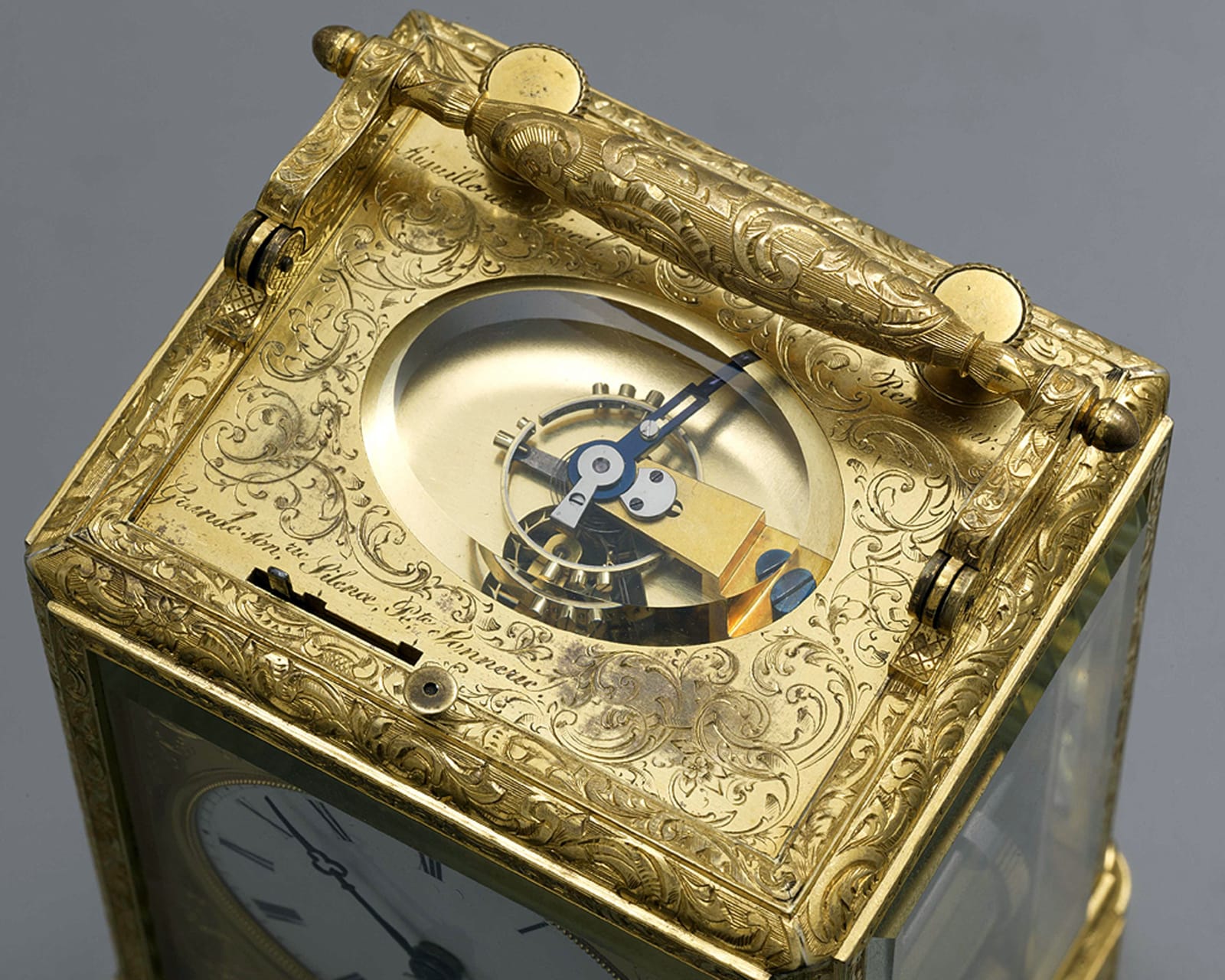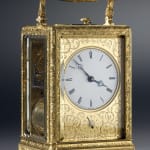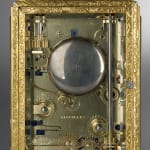Breguet Neveu Compagnie
Further images
Provenance
Count Pavel Dmitrievich Kiseleff (or Kiselyov), purchased from Breguet Nevue Compagnie in Paris 25th May 1844.
A superb and very rare Louis-Philippe gilt brass grande and petite sonnerie striking carriage clock of eight day duration made by the eminent firm of Breguet Neveu Compagnie à Paris for Count Pavel Dmitrievich Kiseleff (or Kiselyov), the white enamel dial signed Breguet below 6 o'clock and also signed and numbered on the backplate N. 1143 Breguet Neveu & Cie, the dial with Roman numerals and a pair of blued steel hands, with a subsidiary seconds ring below the main dial with a blued steel pointer. The superb movement with two barrels, one for the going and one for the striking, with chronometer escapement, remontoire, grande and petite sonnerie striking, repetition on request, alarm and silence, striking on two bells (one hammer for the hour strike on the larger bell and on both bells for the quarter strike and a separate hammer for the alarm). The foliate engraved Gorge case with conforming mask and top with glazed door to the back, the top with a hinged baluster-shaped carrying handle and an oval escapement viewing aperture, with a lever for the adjustments marked: Grande Son.rie Silence. Pte Sonnerie and with two plungers marked Rementoir and Aiguille de Reveil. Accompanied by a Breguet certificate numbered 4342 from Place Vendôme Paris, which notes that the clock was sold on 25th May 1844 to "Monsieur de Kisseleff [sic] le No 1143, petit pendule de voyage à granole et petit sonnerie en passant, silence, répétition à volanté et rèveil, remontage du rèveil et conduit de l'aiguille ayant lieu à l'extèrieur, boite bronze ciselé, cadran èmail, chiffres romains, aiguilles acier; pour le prize de 1600 francs"
Paris, date 1844
Height with handle: 16 cm.
The history of the carriage clock industry is indebted to the most esteemed clockmaker Abraham-Louis Breguet (1743-1823) whose first carriage clock was delivered to Napoleon Bonaparte in 1796 shortly before he embarked on his Egyptian campaign. Breguet's ability for quality and innovation earned him international recognition. Even after his death the firm's outstanding repute continued and for this reason was patronized by royalty, aristocracy and leading society figures. The present clock is no exception for it was purchased by Count Pavel Dmitrievich Kiseleff (1788-1872), 1844. In that same year the firm, then known as Breguet Nevue Compagnie also supplied a comparable grande and petite sonnerie carriage clock, likewise with repeat, alarm and a chronometer escapement to Prince Anatole Demidoff.
Abraham-Louis Breguet set up his business circa 1775 in the heart of the Parisian clockmaking district at Quai d'Horloge. At first the business was known as Breguet and remained so until he was joined by his son Louis-Antoine Breguet (1776-1858) in 1807 when it was renamed Breguet et Fils. When Louis-Antoine retired in 1833, his son Louis-Clement-François (1804-83) went into partnership with one of his relatives to form Breguet Nevue Compagnie. Eventually his son called Antoine-Louis took over. Since he was the last family member wishing to continue the business, he then took his English foreman Edward Brown into partnership and in 1870 Brown became the proprietor of the esteemed House of Breguet.
Following the formation of Breguet Nevue, the firm enjoyed an illustrious patronage; for instance in August 1834 they sold a Pendule Sympathique to King Louis-Philippe and also in the same year a grande and petite sonnerie carriage clock to Count Anatole Demidoff (who later became a Prince when he married Princess Mathilde Bonaparte). The following year, 1835 the firm sold a carriage clock to Madame Baudin that was later owned by Sir John Prestige before it entered the British Museum Collection. In addition to the present example and that purchased by Anatole Demidoff in 1844, other carriage clocks from that year included several others with a chronometer escapement, either with grande and petite sonnerie or sonnerie ordinaire, which were listed in Breguet Nevue's advertisements for that year. All were of the finest quality, for instance the present clock has a remontoire - a device only found in high quality clocks to maintain accuracy. The remontoire winds an auxiliary spring or weight at regular short intervals to provide a more constant driving force to the escapement.
Like Anatole Demidoff, Pavel Dmitrievich Kiseleff was of Russian birth; he spent most of his life pursuing a military and diplomatic career during which he distinguished himself as a major social reformer during Nicolas I's turbulent reign as Tsar. Kiseleff served as an aide-de-camp at the Battle of Borodino, 1812. Later as Chief of Staff in Tulchyn, Podolia, he began implementing his reforms, for instance by condemning corporal punishment. During the Russo-Turkish war of 1828-9, Kiseleff commanded the Russian occupying troops in Wallachia and Moldavia and remained the most powerful man in the Danubian Principalities, introducing major social and civil improvements there. He returned to St. Petersburg in 1834 where he was admitted to the State Council and became involved in debates concerning the emancipation of serfs. Yet such reforms were so strongly opposed by the conservative landlords that the Tsar abandoned them. Two years later Kiseleff was appointed Imperial Minister of State Properties, an important position he very effectively held for 18 years. When in 1839, Kiseleff became a Count, he reformed the administration of state-owned peasants and also instituted an educational system for peasant children. However he was unable to instigate other reforms due to the rising opposition from the reactionary forces, which persisted up until Nicolas's death. The latter's successor Alexander II then dispatched Kiseleff to Paris as Minister Plenipotentiary with responsibility for dealing with the effects from the Crimean War. For the rest of his life he stayed on and off in Paris where he purchased this clock and where he subsequently died ten years after retirement.
Pavel Dmitrievich and his wife Sophie made a very handsome couple; her portrait by the English artist George Hayter, painted in Paris 1831, the year of their marriage, shows her to be a woman of striking appearance with aquiline features, pale complexion and dark hair decorated with autumnal leaves to offset the colours of her dress. The couple had only one child, a son born in 1822 who sadly died two years later. Thereafter the Count turned much of his attention and hope for the future on his nephews. The Countess found solace in gambling for which she gained infamous repute when immortalized as one of the characters in Fydor Dostoyevsky's novel 'The Gambler'. Sophie took annual retreats to the spa town of Bad Homburg where she had a residence known as Villa Kiseleff; whilst there she became a frequent visitor as well as part owner of the newly built casino, which opened in 1841. Many society figures went there but few suffered such losses for she reputedly gambled away 500,000 florins in a single night. The municipality was however so grateful to her income that it named the street in which the casino stood in her honour. It was there during the 1850's that she met Dostoyevsky who was himself a compulsive betting man and reputedly wrote 'The Gambler' in 30 days to pay off his own debts. The main character Alexis Ivanovitch, who lost so much at the casino, was largely a self portrait whilst the character of Antonida Vasilevna, the grandmother was based on the Countess Sophie, who like Antonida had a compulsion for roulette which eventually stripped her of a large part of her fortune. 'The Gambler', published in 1867 met with considerable acclaim and went on, in 1917, to inspire an opera of the same name by Prokofiev.
ABRAHAM-LOUIS BREGUET, (1747-1823). FRENCH
France's most eminent horologist, Abraham-Louis Breguet revolutionised the design, techniques and image of watch and clockmaking. His work was luxurious, expensive and of superlative quality .He was appointed watchmaker to Louis XVI and Marie Antoinette, and later to Napoleon. He was also patronised by the Tzars of Russia, the English royal family, the Queen of Naples and of Spain and the high aristocracy. Breguet time pieces can be found worldwide, including London's Biritish Museum, Victoria and Albert Museum, the Guildhall and Buckingham Palace nd in Paris at the Conservatoire des Arts et Metiers.
Breguet was born in Neuchatel, Switzerland. In 1762 he travelled to Paris, serving n apprenticeship to a watchmaker in Versailles; he may also have worked for .Berthoud (1727-1807) or for J. A. Lepine (1720-1814). Breguet studied mathematics t the College Mazarin under Abbe Marie who introduced him to many future clients among the aristocracy. Breguet's marriage to Cecile 1'Huillier provided him width enough capital to start his own business, 1775; while contacts he had made through Abbé Marie had almost immediate effect. In 1780 he supplied Duc d'Orleans with a sophisticated self-winding watch, two years later he provided another for Marie Antoinette. Breguet received further finance through his partnership with Xavier Gide, known as Breguet et Cie, (1787-1791). During the heat of the Revolution and under the protection of his friend Marat, Breguet fled to Geneva .During his exile he strengthened contacts and developed new ideas which he immediately implemented upon his return to Paris 1795. One of his first steps was the launch his heaper "souscription" watch, simple to make yet reliable to use.
Breguet applied science and mathematics to the industry, his refinements and innovations considerably added to the art of horology particularly in creating more accurate time keepers and in reducing a watch's thickness. He produced the first “automatic" watch and invented the "parachute", c. 1790 - the first example of shock protection (still used today). He also produced watches for the blind, while his musical watches achieved technological and artistic heights. His style was as radical as it was elegant, he replaced conventional Roman numerals with Arabic, and typically pierced the tips of the hands with a "moon".
n 1807 he took his son, Antoine-Louis (1776-1858) into partnership. The new firm f Breguet et Fils was extremely prosperous as diplomats and aristocrats travelled to Paris during the Napoleonic Campaigns. Breguet also established representativest throughout the world, from London to Madrid and Constantinople to Moscow. During the final decade of his life Breguet received some of the highest accolades; he was appointed a Chevalier de la Legion D'Honneur, a member of the French Board of Longitude, Horologer de la Marine in 1815 and was elected to the Academie Royale des Sciences, 1816. On his death, Breguet et Fils was continued by his son, Antoine-Louis, who was later joined by his own son, Louis-Clement-Frangois (1804-1883), and in turn Louis-Antoine (1851-82) who brought in Edward Brown as successor, while the Breguet family diversified into electricity ,telegraph and aeronautics. The current firm, Montres Breguet continues to produce an exclusive range of watches based on the classic designs of its founder, Abraham-Louis Breguet.
Copyright 1994 by Richard Redding Antiques Ltd. All rights reserved!





